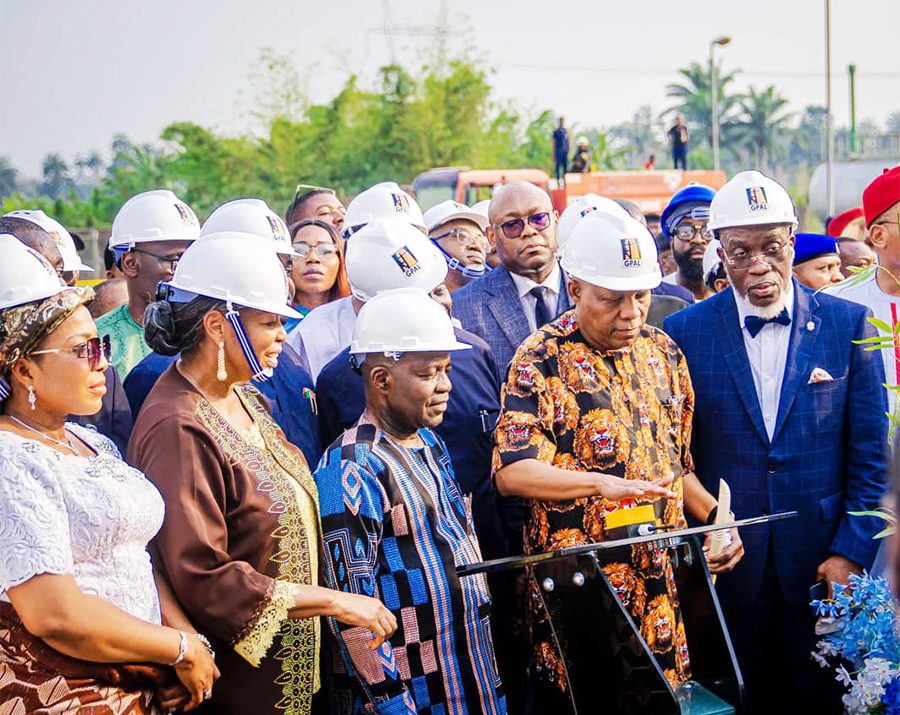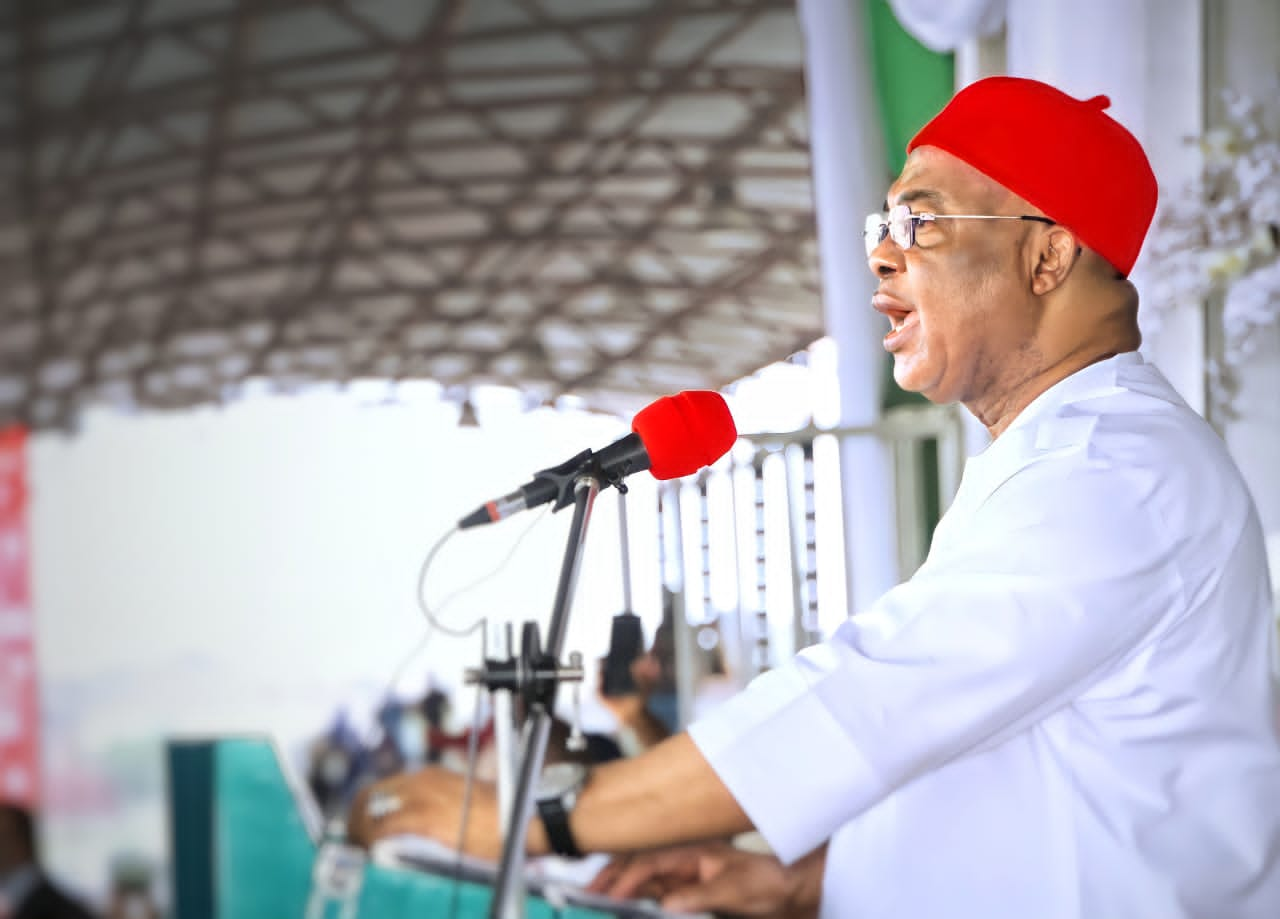The commencement of operation of the Geometric Independent Power project in Aba, Abia State last week should be seen as a clear signal to local and international investors that Aba is open for business, writes Emmanuel Ugwu
There were palpable collective sighs of relief in Aba as Nigeria’s Vice-president, Kashim Shettima switched on the first turbine of the Geometric Power Group’s 141 MW thermal power plant on Monday February 26, 2024. In fact, if the sighs of relief were to be loudly expressed it would have boomed like thunder and reverberated far and wide. The inauguration of the power plant after 20 years of incubation marked the realisation of the dream of Professor Barth Nnaji, the Chairman/CEO of Geometric Power Group.
He said that he was inspired by Prof Ngozi Okonjo-Iweala and the late President of the World Bank, James Wolfensohn to dream the possibility of putting in place a power infrastructure that could provide uninterrupted electricity to Aba, the commercial and industrial hub of Abia State. As Nigeria’s finance minister at the time, Okonjo-Iweala, who is now the Director General of the World Trade Organization(WTO), had in 2004 invited Wolfensohn to Aba to witness first hand the huge economic and technological potentials of the city.
The visit opened the eyes of the World Bank boss to the plethora of small, medium and large scale enterprises that could blossom to boundless limits if only constant power supply was made available. While narrating the genesis of his dream at a recent Igbo leadership colloquium, Nnaji said that “after the visit in 2004, the duo asked me to consider building a 50-megawatt power plant in Abia for manufacturers, both big ones like the Star Paper Mill and small ones like the hundreds of excellent shoemakers and clothiers at the famous Ariaria Market”.
The former minister of power, who is a professor of mechanical and industrial engineering said that the idea was sold to him having previously demonstrated his capability. Nnaji attracted attention after leading a small team of dedicated Nigerian engineers and entrepreneurs to build a 22 megawatt Emergency Plant in Abuja in 2001 for the supply of electricity to State House, the NNPC headquarters, the Abuja Business District, and other places’ ‘. He not only bought the idea of building a 50MW power plant in Aba but decided to embark on a bigger project of building a 141 MW plant expandable to 188MW.
Thus, the $800 million integrated power project (IPP) in Aba was conceived. At the inauguration ceremony, Nnaji described the project as “a child of necessity” given that the autonomous power project was conceived at a period when Nigeria’s power supply woes were suffocating the manufacturing sector with factories shutting down and investments collapsing.
The Geometric Power plant is Nigeria’s only IPP in that the firm is licensed to generate and distribute power. This means that Geometric Power Group is both a power generating company(Genco) and distribution company(Disco) rolled into one. Its two subsidiaries, Geometric Power Aba Limited(GPAL) and Aba Electric Company Limited (Aba Power) perform the functions of Genco and Disco, respectively. On his choice of Aba for the huge investment, Nnaji said that he had actually “enthusiastically accepted” the proposal to embark on the IPP because the plant would be located in Aba. “This city,” he explained, “has a special place in the heart and mind of every person interested in our country’s rapid progress: It is the home of indigenous manufacturing, innovation, and entrepreneurship”.
But if Nnaji had thought that the integrated power project would be completed in scheduled time he was in for a numbing surprise. From the first step, the project was plagued by one hurdle or the other, including financing problems. Abia State Governor, Alex Otti, who as a bank chief when Nnaji was sourcing for funds shared his personal story about Geometric tortuous journey, saying that Prof Nnaji had in 2010 met him at First Bank, Lagos where he was serving as an Executive Director. “He needed the support of the bank to complete the project, the funding of which had been unfortunately stopped two years before, by the bank that originally started the project. This bank happened to be Diamond Bank,” Otti said.
“After securing approval for an $85m facility from First Bank of Nigeria, Geometric Power could not draw on the facility as it had become public knowledge that I was resuming as the Group Managing Director of Diamond Bank, shortly. As I resumed in Diamond on March 1, 2011, I put together a team that saw to the restructuring of the challenged facility and resumed funding of the project to completion”.
With the credit facility secured from Diamond Bank, Nnaji was able to procure three turbines from General Electric in 2014 and completed the 12-inch 27 km gas pipeline from Owaza in Ukwa West Local, the source of the feed gas to Osisioma industrial layout, Aba. The pipeline alone gulped $50 million. Yet, there were still concentric layers of knotty issues strewn on the way. These problems were mostly caused by official bungling.
The oil field at Owaza from where the dedicated pipeline would feed the plant with uninterrupted natural gas flow became encumbered after the NNPCL took over ownership following the federal government’s refusal to renew the oil mining lease(OML) 11 and 17 operated by SPDC Joint Ventures. Nnaji said that Geometrics had already signed an agreement with SPDC in 2009 before the oil field changed ownership. While SPDC engaged FG in a legal battle over the ownership of the Owaza oil field, the NNPCL did not make any investments for gas extraction for the three years the court case lasted. With the eventual resolution of the gas issue, Nnaji said that Hertz Energy and NNPCL “are working together to ensure that we get the gas we need because no gas, no power”.
Perhaps, the most callous of the official bunglings was the manner the privatization of the power sector was handled by the Bureau for Public Enterprises (BPE). During the unbundling of the Power Holding Company of Nigeria(PHCN), in November 2013, Interstate Electrics Limited, the core investor in the Enugu Electricity Distribution Company (EEDC) got the license to supply power to the entire South East zone comprising Abia, Anambra Ebonyi, Enugu and Imo states. The Aba Ring-fenced area covering nine Local Governments out of the 17 Abia LGs had been ceded to Geometric Power in its memorandum of understanding (MoU) with the Federal Government in 2004.
Curiously, the privatisation gurus, wittingly or unwittingly, went ahead and included the area in the EEDC operational area. The Aba Ring-fenced area comprising Aba North, Aba South, Obingwa, Osisioma, Isiala Ngwa North, Isiala Ngwa in South, Ugwunagbo, Ukwa East and Ukwa West became a source of hot dispute between Geometric and EEDC. The parent company of EEDC, Interstate Electrics, promoted by billionaire businessman, Chief Emeka Offor, saw the Aba Ring-fence as a prized asset and would not let go even when it was obvious that the Aba Ring-fenced area was included for EEDC by mistake.
The ownership tussle that ensued over the Aba Ring-fence led to a legal battle between Geometric and EEDC that lasted for nine years. It was eventually settled out of court through the interventions of various stakeholders. But at the end of it all Geometric Power came out bruised. Its commencement of commercial operations was delayed by 10 years and it was also made to pay $26 million to Interstate Electrics as settlement.
This payoff to Interstate Electrics was for the cost of 60 percent interest in the Aba Ring-fenced, five years of IRR(initialism of internal rate of return), and premium on 60 percent value of the Aba Ring-fenced area. The settlement fund was provided by the AfreximBank, with headquarters in Cairo, Egypt. The critical role played by the bank to free Geometric from the entanglement of EEDC was amply recognised at the inauguration ceremony of Geometric Power plant. The Managing Director of AfreximBank, Professor Okey Oramah, was profusely praised by VP Shettima, Governor Otti and Prof Nnaji for facilitating the intervention of his bank to end the tussle between Geometric and EEDC.
Apart from the payment of settlement money to Interstate Electrics, Geometric also lost a huge sum of revenue to the dispute. While it was purchasing power from the Niger Delta Power Holding Company(NDPHC) to provide electricity to Aba it was losing revenue to EEDC. According to Geometric, the EEDC was still collecting revenue from Aba consumers while engaged in the legal battle without investing in improving the power infrastructure.
After the tortuous journey of translating a dream to reality, the inauguration of the Geometric Power plant was welcomed with huge excitement, including cultural displays by troupes from across the Southeast. The ceremony was graced by many dignitaries from far and near, a testimony of the huge significance of this private sector investment in efforts to solve Nigeria’s electricity problem. It is considered the biggest single investment in the SouthEast region.
The Federal Government has already identified the Aba IPP as a critical component in the nation’s quest to attain stable power supply. The Vice President, who represented President Bola Ahmed Tinubu at the historic event, described the Geometric plant as “a game changing project”, adding that Mr. President “is mightily proud” of both the project and its founder, Prof Nnaji. Shettima paid tribute to Nnaji’s resilience in scaling every hurdle placed on his way in the process of building the power plant, saying that it “bears testimony to the power of dreams; where there is a will, there’s a way”.
Minister of Power, Adebayo Adelabu said that Geometric Power Group has become “a national asset” given the feat it has achieved and the role it’s going to play in resolving Nigeria lingering power problems within his tenure. Though Geometric is serving only the Aba Ring-fenced area, when it eventually goes full blast to 188 MW of power generation it would feed the national grid with the excess power as Aba would not immediately consume all of 141MW. The power plant has four turbines each of which generates 47MW, giving a total capacity of 188MW.
Governor Otti in his speech aptly entitled “The Power to dream’’ said that the commencement of firing Geometric first gas turbine is a celebration of “the actualisation of a lofty dream, the beginning of a new epoch and the reaffirmation of our limitless abilities as a people’’. “Certainly, the success of this power project will not just validate my unyielding belief in Aba but would send a clear signal to local and international investors that Aba is open for business,” he said.
Though the ultimate goal of Geometric Power Group is to provide 24 hour steady power supply in its service area, covering 52 percent of Abia LGs, Nnaji said that it would not be automatic. He said that consumers would get to enjoying uninterrupted electricity in due course after the installation of the second of the four turbines. According to him, the turbines would be inaugurated in phases, each coming after monitoring the successful performance of the previous one.
No matter. The journey to steady power supply has started in Aba. As Okonjo-Iweala stated in her goodwill message to Geometric, “there is no reason why any household in Nigeria should not have (constant) electricity”.





